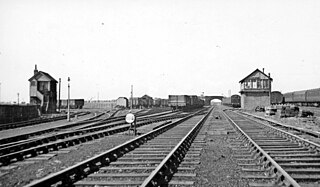Related Research Articles

The London, Midland and Scottish Railway (LMS) Princess Royal Class is a class of express passenger 4-6-2 steam locomotive designed by William Stanier. Twelve examples were built at Crewe Works, between 1933 and 1935, for use on the West Coast Main Line. Two are preserved.

The Cumbrian Coast line is a rail route in North West England, running from Carlisle to Barrow-in-Furness via Workington and Whitehaven. The line forms part of Network Rail route NW 4033, which continues via Ulverston and Grange-over-Sands to Carnforth, where it connects with the West Coast Main Line.
A number of different numbering and classification schemes were used for the locomotives owned by the London, Midland and Scottish Railway (LMS) and its constituent companies; this page explains the principal systems that were used.

The London, Midland and Scottish Railway (LMS) Fowler 2-6-4T was a class of steam locomotive passenger tank engine designed by Henry Fowler.

The Midland Railway (MR) 2441 Class was a class of steam locomotive. They were introduced by Samuel Johnson in 1899, originally with round-topped fireboxes. Henry Fowler later rebuilt them with Belpaire fireboxes. They were given the power classification 3F. The LMS Fowler Class 3F of 1924 was based on this design.

The L&YR Class 21 is a class of small 0-4-0ST steam locomotive built by the Lancashire and Yorkshire Railway for shunting duties. They were nicknamed Pugs.

The Midland Railway (MR) 3835 Class is a class of 0-6-0 steam locomotives designed for freight work. The first two were introduced in 1911 by Henry Fowler. After the grouping in 1923, the designs were slightly modified and continued to be built up to 1941 by the LMS as the LMS Fowler Class 4F.

The London and North Western Railway (LNWR) Improved Precedent Class or Renewed Precedent Class is a class of 2-4-0 steam locomotives originally designed for express passenger work. They later gained the nickname of Jumbos.
The Midland Railway 990 class was a class of 4-4-0 steam locomotive. Ten were built by the Midland Railway in 1907–1909, with simple expansion, to compare with the 1000 class compounds, with which they shared many features. Initially built as saturated, from 1910 to 1914, they were equipped with superheated boilers. These locomotives were well known for their work North of Leeds, over the demanding Settle and Carlisle route.
The Furness Railway Company owned many different types of locomotives, built by several locomotive building companies, including Sharp Stewart and Company. Others were built by the Furness' constituent companies - the Whitehaven and Furness Junction Railway, among others.

The Midland Railway 2000 Class was a class of 40 0-6-4T steam locomotives designed by Richard Deeley. They were known as "flatirons" or "hole-in-the-wall tanks" because of their distinctive shape; their side tanks extended to the front of the smokebox and they had a distinct cut-out in the side tanks to access the motion. They were numbered 2000–2039.

The GER Classes S46, D56 and H88 were three classes of similar 4-4-0 steam locomotive designed by James Holden and A. J. Hill (H88) for the Great Eastern Railway.

The Cleator & Workington Junction Railway (C&WJR) was located in West Cumberland in Northern England, serving the towns of Cleator Moor and Workington and intermediate villages. It was mainly used for coal, limestone and iron ore traffic for the local industries.
The Midland Railway Johnson 0-6-0 were a class of locomotives serving Britain's Midland Railway system in the late 19th and early 20th centuries. Between 1875 and 1908 the Midland Railway, under the control of locomotive superintendents Samuel Waite Johnson and Richard Deeley, ordered 935 goods tender engines of 0-6-0 type, both from the railway's own shops at Derby and various external suppliers. Although there were many variations between different batches both as delivered and as successively rebuilt, all 935 can be regarded as a single series, one of the largest classes of engine on Britain's railways. The locomotives served as late as 1964, but none of them now survive.

The London and North Western Railway (LNWR) Prince of Wales Class was a class of express passenger locomotive. It was in effect, a superheated version of the Experiment Class 4-6-0.

The London and North Western Railway (LNWR) Experiment Class was a class of 4-6-0 steam locomotive designed by George Whale.

The London and North Western Railway (LNWR) Waterloo Class was a class of 2-4-0 steam locomotives that was also known as the Whitworth Class.

The Furness Railway 115 class, was a class of five 4-6-4 tank locomotives of the Furness Railway. They were designed by David Rutherford and built by Kitson and Company in 1920–1921. They were nicknamed "Jumbos" and the author Bob Rush gave them the unofficial classification N1. Their main duty was to haul express passenger trains between Carnforth and Whitehaven.

Harrington railway station, or Church Road halt, was a railway station in Harrington, Cumbria, England. It was opened by the Cleator and Workington Junction Railway (C&WJR) on the company's Harrington Branch which connected with the Lowca Light Railway at Rosehill to provide a through route from Lowca to Workington Central and beyond.
The Glasgow and South Western Railway (G&SWR) 279 class was a class of 0-6-0 steam locomotive designed by Peter Drummond, of which 15 were built in 1913 by the North British Locomotive Company at its Queens Park works. Originally built as the 279 class, as a result of renumbering they became known as the 71 class in 1919, before passing to the London Midland and Scottish Railway (LMS) on its formation in 1923, where they were given power classification 4F.
References
- Baxter, Bertram (1984). Baxter, David (ed.). British Locomotive Catalogue 1825–1923, Volume 4: Scottish and remaining English Companies in the LMS Group. Ashbourne, Derbyshire: Moorland Publishing Company. pp. 221–222.